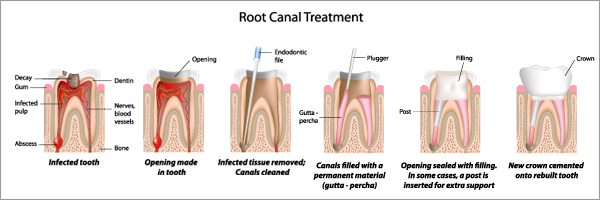Root Canal Treatment (RCT)
Root canal treatment, also known as endodontic treatment, is a dental procedure in which the diseased or damaged pulp (central core) of a tooth is removed and the inside areas (the pulp chamber and root canals) are filled and sealed.
Purpose
An inflamed or infected pulp is called pulpitis. It is the most common cause of a toothache. To relieve the pain and prevent further complications, the tooth may be extracted (surgically removed) or saved by root canal treatment.
Demographics
Root canal treatment has become a common dental procedure. According to the American Association of Endodontists, more than 14 million root canal treatments are performed every year, with a 95% success rate.
Description
Inside the tooth, the pulp of a tooth is comprised of soft tissue that contains the blood supply, by which the tooth receives its nutrients; and the nerve, by which the tooth senses hot and cold. This tissue is vulnerable to damage from deep dental decay, accidental injury, tooth fracture, or trauma from repeated dental procedures such as multiple fillings or restorations over time. If a tooth becomes diseased or injured, bacteria may build up inside the pulp, spreading infection from the natural crown of the tooth to the root tips in the jawbone. Plus accumulating at the ends of the roots can form a painful abscess that can damage the bone supporting the teeth. Such an infection may produce pain that is severe, constant, or throbbing. It can also result in prolonged sensitivity to heat or cold, swelling, and tenderness in the surrounding gums, facial swelling, or discoloration of the tooth. In some cases, however, the pulp may die so gradually that there is little noticeable pain.

Root canal treatment is performed under local anesthesia. A thin sheet of rubber, called a rubber dam, is placed in the mouth and around the base of the tooth to isolate the tooth and help to keep the operative field dry. The dentist removes any tooth decay and makes an opening through the natural crown of the tooth into the pulp chamber. Creating this access also relieves the pressure inside the tooth and can dramatically ease pain.
The dentist determines the length of the root canals, usually with a series of x rays. Small wire-like files are then used to clean the entire canal space of diseased pulp tissue and bacteria. The debris is flushed out with large amounts of water (irrigation). The canals are also slightly enlarged and shaped to receive an inert (non-reactive) filling material called gutta percha. However, the tooth is not filled and permanently sealed until it is completely free of active infection. The dentist may place a temporary seal, or leave the tooth open to drain, and prescribe an antibiotic to counter any spread of infection from the tooth. This is why root canal treatment may require several visits to the dentist. Once the canals are completely clean, they are filled with gutta percha and a sealer cement to prevent bacteria from entering the tooth in the future. A metal post may be placed in the pulp chamber for added structural support
During a root canal, the diseased pulp of a tooth (A), is removed (B). The remaining empty tooth is filled and sealed with a filling or crown. (Illustration by GGS Inc.)
Port and better retention of the crown restoration. The tooth is protected by a temporary filling or crown until a permanent restoration may be made. This restoration is usually a gold or porcelain crown, although it may be a gold inlay, or an amalgam or composite filling (paste fillings that harden).
Diagnosis/Preparation
Signs that a root canal treatment is necessary include severe pain while chewing, prolonged sensitivity to heat or cold, or a darkening of the tooth. Swelling and tenderness of the gums or pimples appearing on the gums are also common symptoms. However, it is also possible that no symptoms will be noticed. The dentist will take an x ray of the tooth to determine if there is any sign of infection in the surrounding bone.
Aftercare
Once a root canal treatment is performed, the recipient must have a crown placed over the tooth to protect it. The cost of the treatment and the crown may be expensive. However, replacing an extracted tooth with a fixed bridge, a removable partial denture, or an implant to maintain the space and restore the chewing function is typically even more expensive.
During the time when antibiotics are being used, care should be taken to avoid using the tooth to chew food. The tooth has been structurally weakened and may break, or there is a possibility of the interior of the tooth becoming reinfected.
If the tooth feels sensitive following the procedure, a standard over-the-counter pain medication such as ibuprofen or naproxen may be taken. This sensitivity will fade after a few days. In most cases the patient can resume regular activity the following day.
Risks
There is a possibility that a root canal treatment will not be successful the first time. If infection and inflammation recur and an x ray indicates a repeat treatment is feasible, the old filling material is removed and the canals are thoroughly cleaned out. The dentist will try to identify and correct problems with the first root canal treatment before filling and sealing the tooth a second time. In cases where an x ray indicates that another root canal treatment cannot correct the problem, endodontic surgery may be performed. In a procedure called an apicoectomy, or root resectioning, the root end of the tooth is accessed in the bone, and a small amount is shaved away. The area is cleaned of diseased tissue and a filling is placed to reseal the canal.
Normal Results
With successful root canal treatment, the tooth will no longer cause pain. However, because it does not contain an internal nerve, it no longer has sensitivity to hot, cold, or sweets. Because these are signs of dental decay, the root canal recipient must receive regular dental checkups with periodic x rays to avoid further disease in the tooth. The restored tooth may last a lifetime. However, with routine wear, the filling or crown may eventually need to be replaced.
Morbidity and Mortality Rates In some cases, despite proper root canal treatment and endodontic surgery, the tooth dies and must be extracted. This is relatively uncommon.
Alternatives
The only alternative to performing a root canal procedure is to extract the diseased tooth. After restoration or extraction, the two main goals are to allow normal chewing and to maintain proper alignment band spacing between teeth. A fixed bridge, a removable partial denture or an implant will accomplish both goals. However, these are usually more expensive than a root canal treatment.






